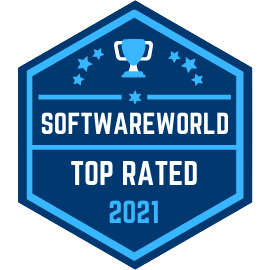The pandemic of 2020 changed the game when it comes to the world of custom software. By forcing the issue of remote work and remote office spaces, the business world had to rethink everything in regards to how they use technology. Let’s take a look at some of the trends that have resulted from this massive rethink of work and workspaces as well as trends that have been around and only continue to grow!
Simple, focused apps
We predict that many people will no longer be looking for applications with tons of features that will do lots of things decently. They are not looking for an app that is a “jack of all trades, master of none.” What we see more people craving are applications that will help them do one thing they need to do very, very well.
This outlook isn’t uncommon for businesses looking to build software for their specific needs. This year, and going forward, you’ll see more and more product companies taking this outlook for the applications they are building. You’re going to see products that are potentially smaller in their feature set, but more specific in the need they are serving to pop up in your app store or on the web. You’ll also see more companies investing in custom software for their own internal needs.
We anticipate new apps are going to be more streamlined. They will specifically select features with a simple, intuitive user interface, and they will be very good at the job they are designed to do.
More targeted software
Similar to simple focused applications, you are going to see more apps that are made for specific audiences.
Over the last 30+ years, there has been a tremendous amount of software that has been created. In the early stages of software products, companies would build a generic software tool that was designed to meet the needs of a broad audience (think Microsoft excel). Since the product had to serve a broad audience, it was common that you would see a very robust set of features. Each user usually only used a subset of the available features to accomplish what they needed.
The current trend is for companies to build software that is more targeted for a smaller set of users. With a narrower audience to market to, the feature set is usually far more tailored to specific use cases.
We think this trend will continue through 2020 and beyond. People are realizing the advantages of having tools that are built for their specific needs. Fumbling those a bunch of unnecessary features to get to the ones you need feels clunky and outdated.
Web-built hybrid apps
For a while, some claimed progressive web applications (PWAs) were the wave of the future. . These applications are device- and platform-neutral, but they always had to be used in a browser window. These kinds of builds came with more than a few cons. The biggest being that users don’t want to have a browser open to use an app and these users cannot access these applications through app stores.
We believe in the cost-effective approach of building web applications that are built and then deployed to desktop, mobile, tablets, or wherever are going to be more and more popular this year. These apps, when used on phones and other mobile devices, will feel like actual apps rather than a website or an app within a browser. Your users will still have access to the main features of your app, but in a way that is more user-friendly and accessible and takes advantage of the built-in functions of a mobile device.
Microservices
Another hot trend you’ll continue to see even more of a push in 2020 is the world of microservices, which is an approach of designing software applications as a suite of independently deployable services. Instead of one large app functioning as a single unit, microservices is an architecture wherein all the components of the system are put into individual components, which can be built, deployed, and scaled individually.
You are seeing big companies such as Amazon, Netflix, and Uber using this approach believing it give them scaling advantages and more agility in their product.
Cloud
People have talked about it for years and years, but 2020 is going to be the year that you will see companies really focus their efforts on getting their software, tools, and data storage into the cloud. While there’s been a steady movement towards this shift, the COVID-19 pandemic is the real catalyst for the substantial change expected to happen this year.
Companies that did not have cloud-based software were unable to adapt as quickly to lockdowns and remote work environments. The pandemic exposed the real vulnerability of sole reliance on physical infrastructure. Those that were left flat-footed with on-site storage and reliance on VPNs realized that they needed to either move up their timeline for transitioning to the cloud or reevaluate their decision not to move to the cloud to be competitive.
Replace old technology
2020 and the following few years, we believe we will see more companies decide to upgrade their old tech. The nineties and early two-thousands saw a lot of companies embrace the new cellular and internet-based technology and build tools that worked well for their employees and customers. However, times have changed, and technology has grown leaps and bounds over these older tools. Still, many companies have chosen to tweak old technology rather than rebuild to embrace new technology with new capabilities.
For those companies with products built using outdated technology to remain competitive, they’ll have to begin upgrading the tech stack. . That old technology, and the old hardware used to support it, is going to become enough of a competitive disadvantage and barrier to new opportunities that companies are going to have no choice but to upgrade and rebuild their tools so they function the way their employees and customers have come to expect technology to work.
Less manual process
Another trend that will continue in 2020 is more companies building software to help their business run smoothly with a focus on ensuring remote employees and remote partnerships are effective.. Companies will continue to evaluate and refine their workflow and process to get rid of as many manual processes as possible, and they will build custom software to help them accomplish this. These applications will allow them to rely less on being physically in their office space to complete a workflow. It may take some time to eliminate all of these manual processes but there will be a massive push to reduce as many manual processes as possible.
AI
Artificial intelligence is nothing new. It’s been and will continue to be an important part of the technology space for a long time. But 2020 is the year of smaller, more personalized technology, and the way AI is used is not exempt from this rule.
While you will still see flashy developments in AI, you will also see AI popping up in smaller pockets of software in ways that will make users’ lives easier. You can expect to see businesses use AI algorithms to make recommendations to employees based on their application usage history, similar to the way YouTube recommends videos you may like based on your viewing history. Businesses and custom software developers will make greater use of AI to enhance features and streamline user experiences.
The bottom line is that you can expect to see AI woven into more and more of the custom software applications you use in small ways that will make them more intuitive and more personal.
It’s an Exciting Time in Custom Software Land!
2020 is an exciting time in the world of custom software. The pandemic, coupled with significant advances in technology, has forced businesses and software developers to think outside of the box when it comes to developing software that meets the needs of businesses and users in a way that ensures that everyone wins.









